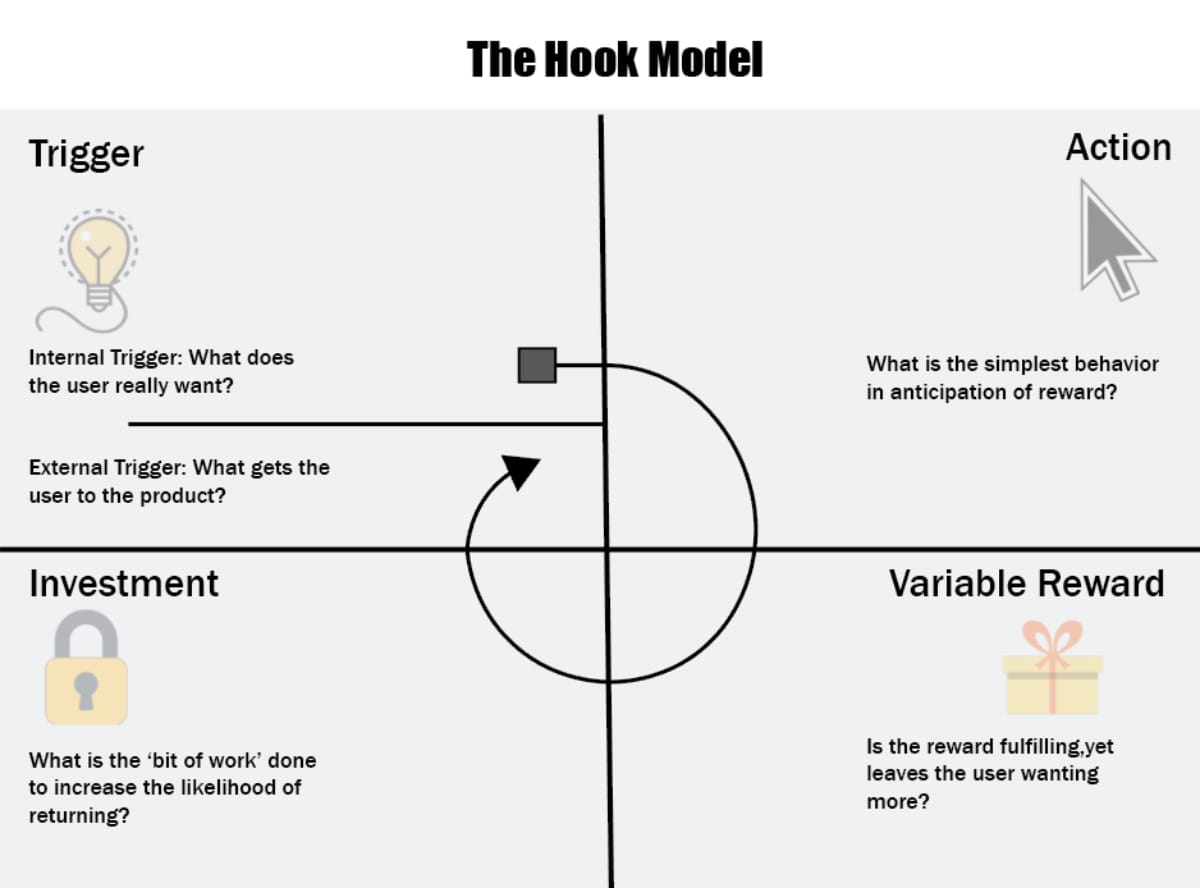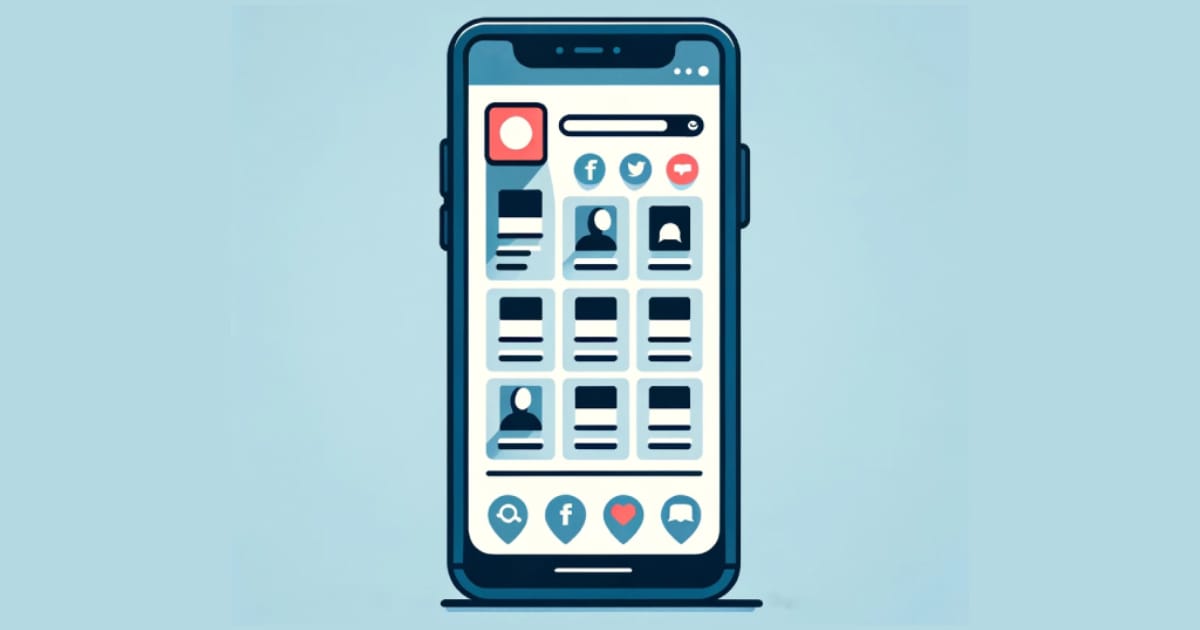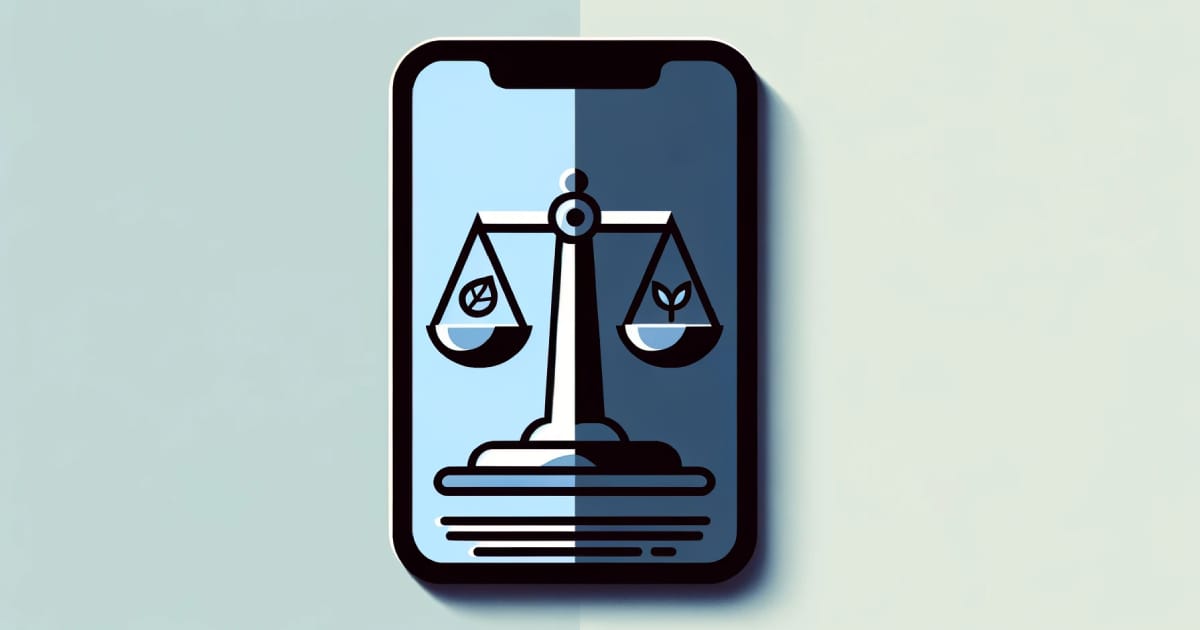How to Build Addictive Products: 'Hooked' Insights

Today capturing attention is like striking gold, crafting products that mesmerize users and keep them coming back has become the sacred quest for developers and marketers alike. Nir Eyal's "Hooked: How to Build Habit-Forming Products" unveils a roadmap for shaping such spellbinding creations. This groundbreaking tome introduces the "Hook Model," a four-phase journey designed to bridge a user's predicament with a company's solution, weaving a tapestry of habit-forming frequencies.
The model's core premise lies in the understanding that products which intertwine themselves into the fabric of users' daily rituals and behaviors can attain unparalleled engagement and loyalty – a bond that transcends mere necessity.
This article plunges into the depths of Eyal's revelations, exploring each facet of the Hook Model and its real-world manifestations. Our aim? To forge a comprehensive guidebook for the visionaries – the entrepreneurs, product masterminds, and design virtuosos – who aspire to craft not just problem-solvers, but products that become an indispensable part of users' lives. Through a tapestry woven from psychological principles and practical applications, we shall traverse the realms of crafting truly addictive offerings – those that beckon users back, not out of obligation, but out of an ingrained habit.
Understanding the Hook Model

The Hook Model, as detailed by Nir Eyal in "Hooked," serves as a blueprint for embedding products into users' lives. By harnessing the power of habit, products can achieve a level of engagement and loyalty that transcends conventional marketing strategies. Here, we dissect the model into its four foundational elements.

1) Trigger
Triggers are the initiators of behavior, the cues that prompt users to take action. They are categorized into two main types: external and internal. External triggers are elements in the user's environment that inform them what to do next through clear calls to action—think notifications, emails, or icons. Internal triggers, on the other hand, are more subtle and powerful. They stem from associations stored in the user's memory and are often linked to emotions or pre-existing routines. For instance, the feeling of boredom might trigger the use of a social media app.
Understanding and leveraging both types of triggers are crucial for creating a product that seamlessly integrates into the user’s life. While external triggers can attract new users, the goal is to cultivate strong internal triggers that ensure long-term engagement without the need for constant reminders.
2) Action
The action phase is where the user performs the behavior in anticipation of a reward. According to Eyal, for an action to take place, it must be made as easy as possible, requiring minimal effort from the user. This simplicity is governed by Fogg’s Behavior Model, which posits that behavior is a product of three factors: motivation, ability, and a trigger. A product that requires low effort to use and is placed in front of a motivated user at the right moment (when the trigger occurs) is more likely to be used repeatedly.
Designing for simplicity involves understanding the user's context, eliminating unnecessary steps, and leveraging technology to reduce barriers to action. For instance, one-click ordering or using autofill for forms can significantly increase the likelihood of completion.
3) Variable Reward
The heart of the Hook Model lies in its third phase, Variable Reward. Drawing from the work of B.F. Skinner on variable ratio schedules, Eyal explains that unpredictability in the rewards received after taking an action can strongly increase a user's engagement and likelihood to repeat a behavior. There are three types of variable rewards: the tribe (social rewards), the hunt (material or informational rewards), and the self (intrinsic rewards for personal gratification).
Products that can master the art of variable rewards, providing users with unexpected but satisfying outcomes, can create a powerful draw. Social media platforms excel at this by offering a mix of social validation, new content, and personal achievement through unpredictable feedback loops.
4) Investment
The final phase of the Hook Model is Investment, which refers to the user's personal contribution to the product. This could be in the form of time, data, effort, social capital, or money. The investment phase increases the product's value to the user, making it more likely they will return. Furthermore, investments done by the user improve the service for them, customizing their experience. For example, learning algorithms use data provided by users to tailor content, making each interaction increasingly personalized and difficult to leave.
Investment leads to the next trigger, creating a loop that, over time, forms habits. Each pass through the cycle consolidates the user's relationship with the product, making the behavior more automatic and the product indispensable.
Applying the Hook Model in Product Design

The Hook Model isn't just theoretical; its principles have been successfully applied across a range of products, particularly in the tech industry. By examining these case studies, we can glean insights into how the model can be adapted and implemented in various contexts.
Case Studies of Successful Applications
- Social Media Platforms: Platforms like Instagram and Twitter are quintessential examples of the Hook Model in action. They utilize external triggers (notifications) to draw users in and internal triggers (feelings of loneliness or boredom) to create a habit. The action of scrolling is made effortless, the rewards (new content, likes, comments) are variable, and users invest by posting content, which further personalizes their experience and draws them deeper into the product.
- Fitness Apps: Fitness apps like Fitbit leverage the Hook Model by triggering users with goals or reminders, simplifying the action of tracking workouts or steps, rewarding users with badges or progress graphics, and asking for investment through goal setting or sharing achievements with friends.
- Language Learning Apps: Duolingo and similar online language learning platforms skillfully apply the Hook Model by setting personalized learning goals and reminders, simplifying language learning into bite-sized lessons. Users are rewarded with points and badges, encouraging continued engagement, while features like daily goals and community challenges foster personal investment. This approach effectively creates a habit-forming loop, driving regular use and engagement in the learning process.
These examples demonstrate how products can create engaging and habit-forming experiences by carefully designing each step of the Hook Model.
Steps to Incorporate the Hook Model into Product Development
- Identify Your Users' Internal Triggers: Conduct user research to understand the emotions or situations that might drive users to your product. This understanding will help you design more effective external triggers and tailor your product to meet users’ needs.
- Simplify the Action: Analyze the user journey to identify and eliminate unnecessary steps. Use technology and design thinking to reduce friction and make it as easy as possible for users to take the desired action.
- Design Variable Rewards: Create a system of variable rewards that can satisfy users’ needs while keeping them engaged and surprised with each interaction. Ensure that the rewards align with the users’ internal triggers and motivations.
- Encourage Investment: Find ways for users to personalize their experience or contribute to the product. This could be through content creation, data input, or social sharing. The more users invest, the more valuable the product becomes to them, and the more likely they are to return.
Ethical Product Design
While designing products to be engaging and habit-forming, it’s crucial to consider the ethical implications. Products should aim to enhance users’ lives without leading to negative addiction or exploiting psychological vulnerabilities. Here are a few considerations:
- Transparency: Be transparent with users about how your product uses their data and how algorithms might influence their behavior.
- User Control: Provide users with tools to control their engagement, such as setting usage limits or notifications preferences.
- Positive Impact: Focus on creating products that have a positive impact on users’ lives, supporting healthy habits and well-being.
Psychological Principles Behind the Model

The Hook Model's efficacy is deeply rooted in established psychological theories and principles. By tapping into these insights, product designers can craft experiences that resonate with users on a subconscious level, driving engagement and loyalty.
The Role of Emotions in Internal Triggers
Internal triggers are often closely tied to emotions, particularly negative ones such as boredom, loneliness, or stress. The principle here is that products can become coping mechanisms for these negative states, creating a powerful incentive for users to return to them. This is rooted in the psychological concept of negative reinforcement, where the removal of a negative state reinforces a particular behavior.
Cognitive Dissonance
The theory of cognitive dissonance, proposed by Leon Festinger, is another psychological principle that underpins the Hook Model. It posits that individuals strive for internal consistency and when confronted with inconsistency (dissonance), they experience psychological discomfort. Products that become part of a user’s identity or routine can create a situation where not using the product feels like a breach of self-consistency, thereby encouraging continued use to avoid dissonance.
Variable Reward Schedules
At the heart of the Hook Model is the principle of variable rewards, a concept derived from B.F. Skinner’s operant conditioning theory. Skinner found that mice would press a lever more frequently when rewards (food pellets) were delivered on a variable schedule rather than a fixed one. This principle applies to humans as well; unpredictability in rewards sustains interest and engagement, compelling users to return to an activity or product in anticipation of a new reward. This mechanism is evident in social media feeds, where users keep scrolling because the next post could be particularly rewarding or interesting.
Investment Principle
The Investment phase of the Hook Model leverages the psychological concept known as the endowment effect, which suggests that people ascribe more value to things merely because they own them or have invested in them. When users invest time, data, effort, or other resources into a product, they value it more highly and are more likely to continue using it. This principle ensures that with each investment, the user's commitment to the product deepens, making the behavior more habitual.
Ethical Considerations
While leveraging these psychological principles can lead to highly engaging and successful products, they also raise ethical questions. The potential for addiction, exploitation of psychological vulnerabilities, and the impact on mental health are concerns that product developers must consider. Ethical product design requires a balance between engaging users and ensuring the product contributes positively to their lives, without causing harm or fostering dependency.
Beyond 'Hooked': Maintaining Long-Term Engagement

Achieving initial user engagement through the Hook Model is only the beginning. The challenge for product developers and companies is to maintain that engagement over the long term, ensuring that users continue to find value and satisfaction in the product. Here are strategies to achieve sustained user engagement, along with ethical considerations.
Continuous Value Delivery
- Regular Updates and Improvements: Keep the product fresh and relevant by continuously updating it with new features, content, or improvements. This not only addresses user feedback but also re-engages users who might have started to drift away.
- Personalization: Use data collected during the Investment phase to personalize the user experience. The more tailored the experience is to an individual’s preferences and habits, the more likely they are to continue using the product.
Leveraging Community
- Building a Community: Encourage the formation of a community around your product. Communities can provide social reinforcement, deepen the sense of belonging, and create internal triggers through social interactions.
- Engagement Through Contribution: Allow users to contribute to the product or community, whether through content creation, feedback, or collaboration. This investment increases the perceived value of the product and reinforces the habit.
User-Centric Innovation
- Feedback Loops: Implement mechanisms to gather and act on user feedback. Showing that you value and respond to user input can increase loyalty and satisfaction.
- Anticipating User Needs: Stay ahead of market trends and user expectations by innovating based on predictive analytics and user behavior patterns. Offering new solutions to emerging problems can reinvigorate user engagement.
Ethical Engagement Practices
Maintaining long-term engagement must be balanced with ethical considerations. It’s crucial to respect user autonomy and promote well-being.
- Promote Healthy Usage Patterns: Design your product to encourage healthy habits. This can include features like usage tracking, reminders to take breaks, or settings that limit notifications.
- Transparency and Control: Ensure users have clear information about how their data is used and give them control over their privacy settings and personal information.
- Positive Impact Focus: Strive to ensure that your product contributes positively to users’ lives, supporting their goals, well-being, and personal growth.
Ethical Considerations in Creating Addictive Products

Creating products that are engaging and potentially habit-forming necessitates a careful ethical examination. As designers and developers harness the power of the Hook Model, they must also consider the impact of their products on users' lives. Here are key ethical considerations to keep in mind:
Prioritizing User Well-being
- Balance Between Engagement and Well-being: While engagement metrics are crucial for a product's success, they should not be pursued at the expense of users' mental or physical health. Products should be designed with features that encourage moderation and prevent overuse.
- Supporting Positive Habits: Products should aim to support positive habits and outcomes for users, enhancing their productivity, learning, health, or social connections.
Informed Consent and Transparency
- Clear User Consent: Ensure that users have a clear understanding of what they are signing up for, especially concerning data collection, privacy, and how their behavior might be influenced by the product.
- Transparency About Algorithms: Provide users with information about how algorithms might shape their experience and the content they see, particularly in cases where it could reinforce certain behaviors or biases.
Respect for Privacy
- Data Protection and Privacy: Uphold the highest standards of data protection and give users control over their personal information. This includes transparent privacy policies and easy-to-use privacy settings.
Preventing Negative Outcomes
- Monitoring for Unintended Consequences: Actively monitor product use to identify and mitigate unintended consequences, such as addiction or negative impacts on mental health.
- Providing Tools for Self-Regulation: Offer tools that help users monitor and manage their usage, such as screen time reports, reminders to take breaks, or the ability to set usage limits.
Encouraging Ethical Design Practices
- Ethical Design Frameworks: Adopt and promote ethical design frameworks within your organization to guide the development process, emphasizing user well-being and positive societal impact.
- Stakeholder Engagement: Engage with users, mental health professionals, and ethicists to gain diverse perspectives on your product's impact and how it can be improved.
Final Thoughts
Building addictive products, as outlined in Nir Eyal's "Hooked," offers profound insights into user behavior and product design. However, the true challenge lies in applying these insights ethically and responsibly. By understanding the psychological underpinnings of the Hook Model and committing to ethical design practices, creators can forge products that not only captivate users but also enrich their lives.
As we reflect on the lessons from "Hooked," it becomes clear that the ultimate measure of a product's success is not just in its ability to engage users but in its capacity to contribute to their well-being and happiness. In this quest, the responsibility rests with creators to innovate with care, ensuring that their products stand as testaments to the positive potential of technology.
Key Takeaways
| Section | Key Takeaways |
|---|---|
| Understanding the Hook Model | - Triggers initiate user behavior. - Action must be simple and easy. - Variable rewards keep users engaged. - Investment increases the product's value to the user. |
| Applying the Hook Model | - Identify user triggers and simplify actions. - Design for variable rewards. - Encourage user investment. |
| Psychological Principles | - Variable rewards create sustained engagement. - Investment deepens user commitment. - Products can leverage emotions as internal triggers. |
| Maintaining Long-Term Engagement | - Deliver continuous value and updates. - Leverage community for deeper engagement. - Innovate based on user feedback. |
| Ethical Considerations | - Prioritize user well-being over engagement metrics. - Practice transparency and informed consent. - Provide tools for self-regulation. |





